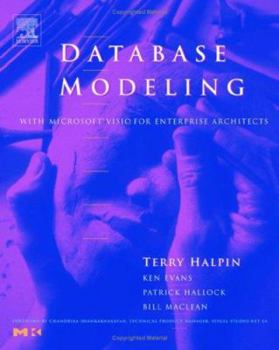Database Modeling with Microsoft(r) VISIO for Enterprise Architects
This book is for database designers and database administrators using Visio, which is the database component of Microsoft's Visual Studio .NET for Enterprise Architects suite, also included in MSDN... This description may be from another edition of this product.
Format:Paperback
Language:English
ISBN:1558609199
ISBN13:9781558609198
Release Date:August 2003
Publisher:Morgan Kaufmann Publishers
Length:425 Pages
Weight:1.65 lbs.
Dimensions:0.8" x 7.3" x 9.2"
Customer Reviews
1 rating
Well written - a pleasure to use
Published by Thriftbooks.com User , 21 years ago
This book allows you to make the most of the database modeling aspect of Visio for Enterprise Architects (VEA).For me finding my way around a new design environment is always time consuming, but following along with the first few chapters made it relatively painless this time. The step-by-step sequences contain not only the usual click this / type that instructions, but often also the reason WHY things are done that way. Sometimes the instructions even anticipate where a newcomer might go wrong. Here is an example from the section that introduces the user interface: "If you unxpectedly get a screen that looks like Figure 3-12 (a screendump with the the menu, toolbar and not much else) you have accidentally hidden the database task pane and should click on View > Task Pane to return to the database menu ...".<p>The book is carefully organised, and you are guided from a general introduction via installation to the various modeling and reverse-engineering activities, with a nice balance of general duscussion and detailed examples. For complex models there are suggestions on using layers to help with documentation and presentations, and on how to make the most of the built-in reports.<br>The book shows you how to use the default settings in order to make VEA do as much work for you as possible; it then shows you where and how you can best override the defaults to fine-tune your design. Sometimes a seemingly simple change can have consequences further down the line and the book points out where you have to be careful and why. If you want to go for round-trip maintenance this book helps you to organise your models to make the process as straightforward as possible.<p>If you are new to Object Role Modeling (ORM) then you will find enough here to show you how powerful it is, and to start using it straight away. If you do not wish to use ORM you can stay with ER models and still be well catered for. <p>I found the explanation of how conflicts are resolved when you synchronise the model and the physical schema after making changes in one (or both!) of them especially helpful. Being aware of the three-way synchronisation process goes a long way to understand the information presented by the wizards.<p>There are many useful hints all through the book, like this one: "The physical validation page of the Generate Wizard is the most likely place for errors to occur during DDL generation. Platform specific rules, such as object name lenghth, reserved words, characters, etc, are not enforced during the modeling phase prior to DDL generation. It is thus possible for a model with no conceptual or logical errors to fail physical validation".<p>The index has been constructed with care, the diagrams are clean and helpful and screen shots are used where appropriate. There is also a handy section with the various ORM, Logical Model and IDEFIX diagram elements.<br>Best of all, the book opens flat so I can use it while I am working without the need for paperweights, bulld





